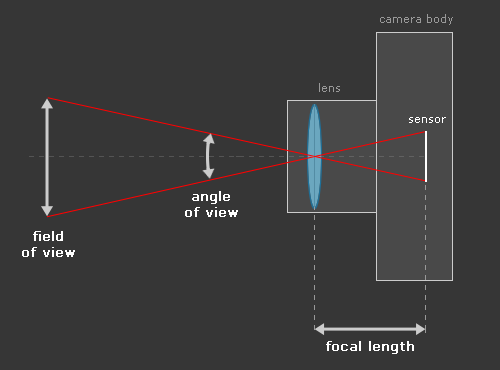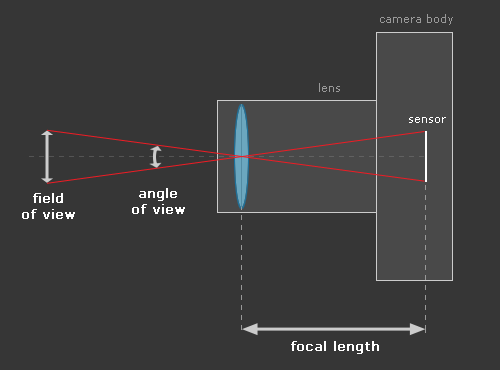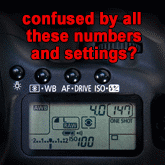This post provides descriptions of some lens terminology that many people take for granted, but are not be clearly understood by everyone, namely
- focal length
- angle of view
- field of view
I'll start with some definitions. Reference the diagram immediately below when reading these definitions.

Focal Length
The focal length of a lens is the distance from the optical centre of the lens to the sensor (or film) when the lens is focused on an object at infinity.
The focal length is fixed for any lens, and doesn't change when the lens is mounted on different camera bodies.
The focal length of a lens is one of the key specifications of a lens. For example, the focal length of the Canon EF-S 18-55mm f/3.5-5.6 IS lens ranges from 18mm to 55mm, depending on the zoom set by the lens' zoom ring. On the other hand, prime lenses such as the Canon EF 50mm f/1.8, have a fixed focal length that cannot be varied (ie, 50mm).
Angle of View
The angle of view is the angle of subject area that is projected onto the camera's sensor by the lens.
In other words, it's the angle over which the sensor can "see" through the lens.
The angle of view depends on the focal length of the lens, and the size of the camera's sensor.
Field of View
The field of view is another way of representing the angle of view, but expressed as a measurement of the subject area, rather than an angle.
The diagram below shows a top view of a camera, and indicates the focal length, angle of view and field of view, for a lens set to a relatively short focal length (say, the Canon EF-S 18-55mm f/3.5-5.6 IS lens set at 18mm).

For the same lens zoomed out (ie, Canon EF-S 18-55mm f/3.5-5.6 IS lens at 55mm), the diagram below shows how the angle of view and field of view are significantly decreased when the focal length is increased.

Terms like focal length, angle of view and field of view will be featuring in future articles, and the intention of this article was to provide a clear description of each of these terms, ensuring that you will know what is meant when you come across these terms in the future.
I have several more articles planned for this Understanding Your Camera series, including a post that will describe the effect of a crop sensor on the field of view.
Be sure to subscribe via RSS or via email to ensure you don't miss any future posts.



The diagrams help. I don't think I understood that the focal length was defined when focused to infinity.
That actually helped to clarify it for me in a more visual sense. Thank you...